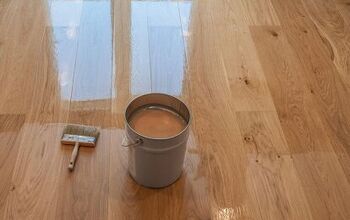What Are The Pros And Cons Of Urethane Grout?

When you’re installing tile or stone, you want to make sure that you choose the right grout for your project. Believe it or not, grout can make or break the perfect backsplash, shower installation, or kitchen floor. What is grout, exactly, and why is it so important in home improvement projects?
Grout is generally a mixture of water, sand, and cement used to fill in the gaps between tile and stone. When it hardens, grout helps to make sure that no dirt or debris settles between or under your tile. It also ensures that your project has a crisp, streamlined finish and is sturdy enough not to crack, shift, or weaken under sustained use. There are three different types of grout: sanded, un-sanded, and epoxy grout. All three have their merits.
Urethane grout— or polyurethane grout— is a sanded grout and has the added bonus of coming premixed. You read that right— urethane grout is a premium, premixed, water-based grout that is both easy to find and use. Even the most rudimentary of DIYers will be able to use urethane grout effectively!
There are several pros and cons to using urethane grout in your home project.
The pros of urethane grout are that it comes premixed and ready-to-use, is stain resistant, has color consistency, and bonds extremely well to just about anything. The cons of using urethane grout are that it can have grout shrinkage, takes a long time to fully cure, and is susceptible to high heat.
Read on to find out if urethane grout will work for your home improvement project.
Do You Need Grout Replacement or Repair?
Get free, zero-commitment quotes from pro contractors near you.

What Are The Pros Of Urethane Grout?
Similar to epoxy, there are a few reasons why springing for a urethane grout would be a good idea.
Ready-To-Use
Urethane grout is a relatively new product to hit the home improvement scene. It comes premixed, which cuts down on your prep time by half. All you have to do is add in a few ingredients and you’re good to go! Follow these simple steps to prep your urethane grout:
Step 1: Carefully open the urethane grout bucket on a hard surface in case of spillage.
Step 2: Pour the accompanying ingredients of sand and polyurethane resins to the bucket.
Step 3: Stir until well mixed.
Badaboom! There you have it. A whole bucket of grout ready to go. Additionally, you’ll be able to reseal the bucket and save for later use. You can either save it for repairs or for another project on your Honey Do List.
Stain Resistant
One of the biggest draws of urethane grout is that it is resistant to most stains, especially if you spring for a darker color. Without a doubt, polyurethane grout holds up better against stains than other types of grout.
The resin additive is what keeps it from holding onto a stain. This makes it ideal for high trafficked areas in your home like bathrooms, entryways, kitchens, and laundry rooms. Polyurethane grout is great for any spot in your home where you’d be especially worried about mud and dirt getting into the grout.
It doesn’t need to be sealed, either!
Color Consistency
One of the best pros of polyurethane grout is the color consistency. Because the color pigments aren’t added to the mixture, the color of the grout remains uniform throughout the installation process.
Colored quartz is used instead as the color base. Even though polyurethane grout is a somewhat new product in the grout aisle, there are still around 40 different colors to choose from. You’ll easily be able to find a shade that matches with whatever tile or stone you’re working with.
Strong Bonding
Extremely pliant and durable, polyurethane grout bonds with just about any material. That’s why it works for so many different home improvement projects. Polyurethane resins and polymers are what bind and hold together the sand particles in urethane grout.
This makes it extremely sticky and more likely to stick to whatever it is you want it to stick to. Its water resistance makes it ideal for bathrooms and kitchens. From backsplash to countertops, it’s going to work really well in making sure your stone or tile doesn’t slip or move around.
More traditional cement-based grouts can get watered down too easily. If you’re the one tackling the tile installation in your bathroom, you definitely run the risk of adding too much water to a cement grout mixture, which will weaken the hold the grout is supposed to have. Not to mention it can also cause discoloration and mottling as the grout dries.
Having a premixed compound like polyurethane grout means that you don’t have to worry about messing with the strength of the potential bond. You’re guaranteed a strong bond every time. Here are few of the materials a polyurethane grout will bond really well with:
- Porcelain
- Ceramic
- Glass
- Metal
- Natural Stone
What Are The Cons Of Urethane Grout?
Even though polyurethane grout is a relatively popular product on the market right now, there are a few drawbacks to using it when compared to other types of grouts.
Grout Shrinkage
One of the things you’ll want to look out for urethane grout is shrinkage. After you’ve applied the grout, you might find that there isn’t quite enough sand in the mixture to provide the grout with a sufficient enough grip. Luckily for urethane users, you don’t have to worry about adding too much or too little sand.
However, what you do have to watch out for is proper installation of polyurethane grout. If you don’t wet the joints before applying your urethane grout, the likelihood of your grout separating from the tile or stone and crumbling over time is higher. It’s important that you do your research before buying a premixed urethane grout.
Repair the Issue Right Away
If your polyurethane grout does shrink, crack, or start to crumble, you’ll want to address the issue straight away. If you wait, the problem will only get worse. Luckily, urethane grout has a long shelf life and color matching is usually not an issue.
If you’ve saved your grout, you can easily step in and repair what has already been damaged. If you need to go back to the store and do a match, the likelihood of you finding something that matches exactly is pretty high, considering there aren’t too many colors to choose from when it comes to urethane grout.
Long Curing Time
If you decide that using polyurethane grout is perfect for your shower or kitchen project, you’re looking at a full 7 days of curing time. That’s right— it’s going to take your grout a full week to fully seal. If you’re working in a shower or a kitchen, that wait time may not be totally ideal. You won’t be able to run water, walk, or shower while your grout is curing. If you don’t wait the full seven days, you’re going to see tile pull away from the grout, shift underfoot, and even crack within just months.
Sensitive to Temperature
Because polyurethane is sensitive to temperature fluctuations, you might have an issue with the grout separating, cracking, or flaking off. Avoid using polyurethane grout around stoves or fireplaces for this exact reason. Many times, DIYers get impatient and don’t wait the full seven days to allow the grout to fully cure. By not waiting, your grout will become more susceptible to high heat temperatures.
Related Questions
Is urethane grout the same as epoxy grout?
No, they’re actually pretty different. Epoxy grout comes with multiple ingredients you have to mix together. You’ll mix a full batch and whatever you don’t use you’ll have to throw away. With a urethane grout, it all comes premixed and can be used for up to 2 years after you’ve opened it.
What is the best waterproof grout?
Epoxy grout and polyurethane grout are going to be the best waterproof grouts. Both require no sealing and are both stain-resistant.
Do you need to seal polyurethane grout?
No, urethane grouts do not require any sort of sealant.
Which is better, cement or urethane grout?
Urethane grout is actually going to be better. You can be more exact and detailed with urethane vs. cement because of its overall consistency and tackiness.
Do You Need Grout Replacement or Repair?
Get free, zero-commitment quotes from pro contractors near you.

Our Takeaway
Even though polyurethane grout is a relatively new product, it works really well when remodeling your kitchen or bathroom. Urethane grout is going to be ideal for a do-it-yourself project. Many professionals are even opting for polyurethane grouts vs. cement-based grouts because it is so easy to work with. You’ll definitely want to keep in mind its extensive curing time and possible shrinkage if you’re working with urethane grout, however. In the end, the pros far outweigh the cons!

Paige is an elementary school librarian with a passion for writing. Her hobbies include reading an exorbitant amount of fantasy, slowly teaching herself to draw, and home decor. While she isn't the most talented artist or interior designer, what she lacks in skill she more than makes up for in enthusiasm. When she's not curled up with a book, you can certainly find her curled over the keyboard.
More by Paige Hanawalt



























